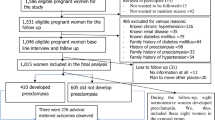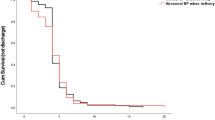Abstract
Today the only effective “treatment” for preeclampsia is to deliver at the optimal time for both maternal and foetal well-being. Studies reported that severe preeclampsia can benefit from the expectant management including mild preeclampsia between 34 and 37 weeks. However it is unclear whether mild preeclampsia before 34 weeks also benefits from the expectant management. Data on 274 women with mild preeclampsia before 37 weeks of gestation were retrospectively collected and analysed. Blood pressure and proteinuria at time of onset were not clinically associated with delivery time. For women who developed preeclampsia before 34 weeks, the median latency from onset to delivery or from onset to admission to hospital or from admission to hospital to delivery was 27 or 21 or 3 days, respectively. There were four women (2%) who delivered within 48 h after onset, 28 (14%) FGR and 14 (7%) stillbirths. The median birth-weight was 2240 g. For women who developed preeclampsia between 34 and 37 weeks, the median latency from onset to delivery or from onset to admission to hospital or from admission to hospital to delivery was 11 or 7 or 2 days, respectively. There were seven women (10%) who delivered within 48 h after onset and eight (12%) FGR. The median birth-weight was 2880 g. Our study demonstrates that mild preeclampsia before 37 weeks has benefits from expectant or outpatient management with a median prolongation of over 11 days dependent on the time of onset, but it increases the risk for stillbirths before 34 weeks.
This is a preview of subscription content, access via your institution
Access options
Subscribe to this journal
Receive 12 digital issues and online access to articles
$119.00 per year
only $9.92 per issue
Buy this article
- Purchase on Springer Link
- Instant access to full article PDF
Prices may be subject to local taxes which are calculated during checkout
Similar content being viewed by others
References
Report of the National High Blood Pressure Education Program Working Group on High Blood Pressure in Pregnancy. Am J Obstet Gynecol. 2000;183:S1–22.
Tranquilli AL, Dekker G, Magee L, Roberts J, Sibai BM, Steyn W, et al. The classification, diagnosis and management of the hypertensive disorders of pregnancy: a revised statement from the ISSHP. Pregnancy Hypertens. 2014;4:97–104.
Sibai B, Dekker G, Kupferminc M. Pre-eclampsia. Lancet. 2005;365:785–99.
Cnossen JS, Morris RK, ter Riet G, Mol BWJ, van der Post JAM, Coomarasamy AZ, et al. Use of uterine artery Doppler ultrasonography to predict pre-eclampsia and intrauterine growth restriction: a systematic review and bivariable meta-analysis. Can Med Assoc J. 2008;178:701–11.
Powers RW, Jeyabalan A, Clifton RG, Van Dorsten P, Hauth JC, Klebanoff MA, et al. Soluble fms-Like Tyrosine Kinase 1 (sFlt1), Endoglin and Placental Growth Factor (PlGF) in Preeclampsia among High Risk Pregnancies. Plos ONE. 2010;5:13263–75.
Xiao J, Shen F, Xue Q, Chen G, Zeng K, Stone P, et al. Is ethnicity a risk factor for developing preeclampsia? An analysis of the prevalence of preeclampsia in China. J Hum Hypertens. 2014;28:694–8.
Dong X, Gou W, Li C, Wu M, Han Z, Li X, et al. Proteinuria in preeclampsia: not essential to diagnosis but related to disease severity and fetal outcomes. Pregnancy Hypertens. 2017;8:60–4.
Belghiti J, Kayem G, Tsatsaris V, Goffinet F, Sibai BM, Haddad B. Benefits and risks of expectant management of severe preeclampsia at less than 26 weeks gestation: the impact of gestational age and severe fetal growth restriction. Am J Obstet Gynecol. 2011;205:465 e1–6.
Bombrys AE, Barton JR, Habli M, Sibai BM. Expectant management of severe preeclampsia at 27(0/7) to 33(6/7) weeks' gestation: maternal and perinatal outcomes according to gestational age by weeks at onset of expectant management. Am J Perinatol. 2009;26:441–6.
Bombrys AE, Barton JR, Nowacki EA, Habli M, Pinder L, How H, et al. Expectant management of severe preeclampsia at less than 27 weeks' gestation: maternal and perinatal outcomes according to gestational age by weeks at onset of expectant management. Am J Obstet Gynecol. 2008;199:247 e1–6.
Sibai BM, Barton JR. Expectant management of severe preeclampsia remote from term: patient selection, treatment, and delivery indications. Am J Obstet Gynecol. 2007;196:514 e1–9.
Hypertension in pregnancy. Report of the American College of Obstetricians and Gynecologists' Task Force on Hypertension in Pregnancy. Obstet Gynecol. 2013;122:1122–31.
Sibai BM. Management of late preterm and early-term pregnancies complicated by mild gestational hypertension/pre-eclampsia. Semin Perinatol. 2011;35:292–6.
Koopmans CM, Bijlenga D, Groen H, Vijgen SM, Aarnoudse JG, Bekedam DJ, et al. Induction of labour versus expectant monitoring for gestational hypertension or mild pre-eclampsia after 36 weeks' gestation (HYPITAT): a multicentre, open-label randomised controlled trial. Lancet. 2009;374:979–88.
Vigil-De Gracia P, Reyes Tejada O, Calle Miñaca A, Tellez G, Chon VY, Herrarte E, et al. Expectant management of severe preeclampsia remote from term: the MEXPRE Latin Study, a randomized, multicenter clinical trial. Am J Obstet Gynecol. 2013;209:425.e1–8.
Broekhuijsen K, van Baaren G-J, van Pampus MG, Ganzevoort W, Sikkema JM, Woiski MD, et al. Immediate delivery versus expectant monitoring for hypertensive disorders of pregnancy between 34 and 37 weeks of gestation (HYPITAT-II): an open-label, randomised controlled trial. Lancet. 2015;385:2492–501.
Hypertension in Pregnancy. American College of Obstetricians and Gynecologists Women's Health Care Physician. Obstetrics & Gynecology, 2013;122:1122–31.
van der Tuuk K, Koopmans CM, Groen H, Aarnoudse JG, van den Berg PP, van Beek JJ, et al. Prediction of progression to a high risk situation in women with gestational hypertension or mild pre-eclampsia at term. Aust N Z J Obstet Gynaecol. 2011;51:339–46.
Lindheimer MD, Kanter D. Interpreting abnormal proteinuria in pregnancy: the need for a more pathophysiological approach. Obstet Gynecol. 2010;115(2 Pt 1):365–75.
James PR, Nelson-Piercy C. Management of hypertension before, during, and after pregnancy. Heart. 2004;90:1499–504.
Magee LA, Ornstein MP, von Dadelszen P. Fortnightly review: management of hypertension in pregnancy. BMJ. 1999;318:1332–6.
Sibai BM, Mercer BM, Schiff E, Friedman SA. Aggressive Versus Expectant Management of Severe Preeclampsia at 28 to 32 Weeks Gestation - a Randomized Controlled Trial. Am J Obstet Gynecol. 1994;171:818–22.
Odendaal HJ, Pattinson RC, Bam R, Grove D, Kotze TJV. Aggressive or Expectant Management for Patients with Severe Preeclampsia between 28-34 Weeks Gestation - a Randomized Controlled Trial. Obstet Gynecol. 1990;76:1070–5.
Valent AM, DeFranco EA, Sibai BM. Expectant management of mild preeclampsia REPLY. Am J Obstet Gynecol. 2015;213:750–1.
Acknowledgements
This study was received the support from Shanxi Province Science and Technology Development project, China (Grant number 2015SF124) and Shanxi Province International collaborative program (Grant number 2016KW-006).
Author information
Authors and Affiliations
Corresponding authors
Ethics declarations
Conflict of interest
The authors declare that they have no conflict of interest.
Additional information
Publisher’s note: Springer Nature remains neutral with regard to jurisdictional claims in published maps and institutional affiliations.
Rights and permissions
About this article
Cite this article
Fu, J., Li, C., Gou, W. et al. Expectant or outpatient management of preeclampsia before 34 weeks: safe for mother but associated with increased stillbirth risk. J Hum Hypertens 33, 664–670 (2019). https://doi.org/10.1038/s41371-019-0175-1
Received:
Revised:
Accepted:
Published:
Issue Date:
DOI: https://doi.org/10.1038/s41371-019-0175-1



